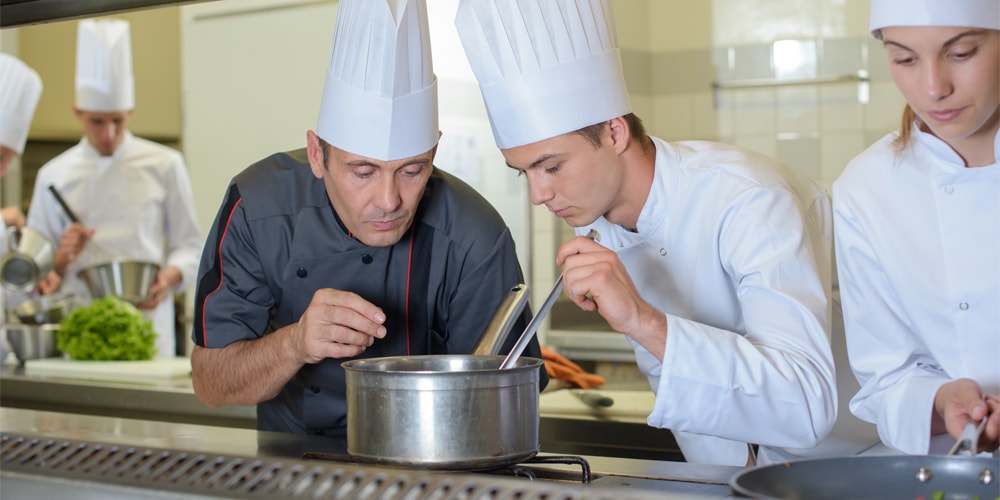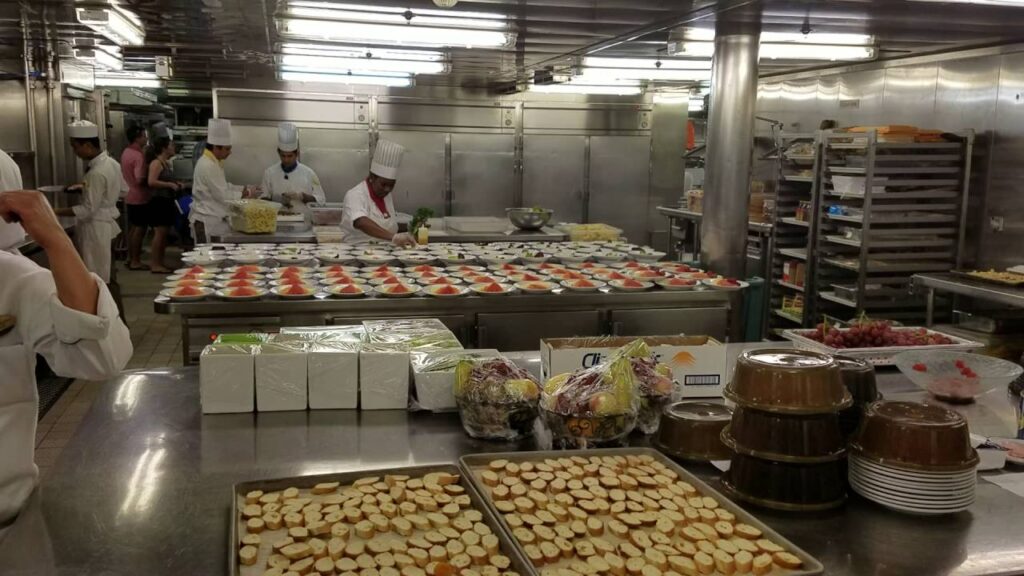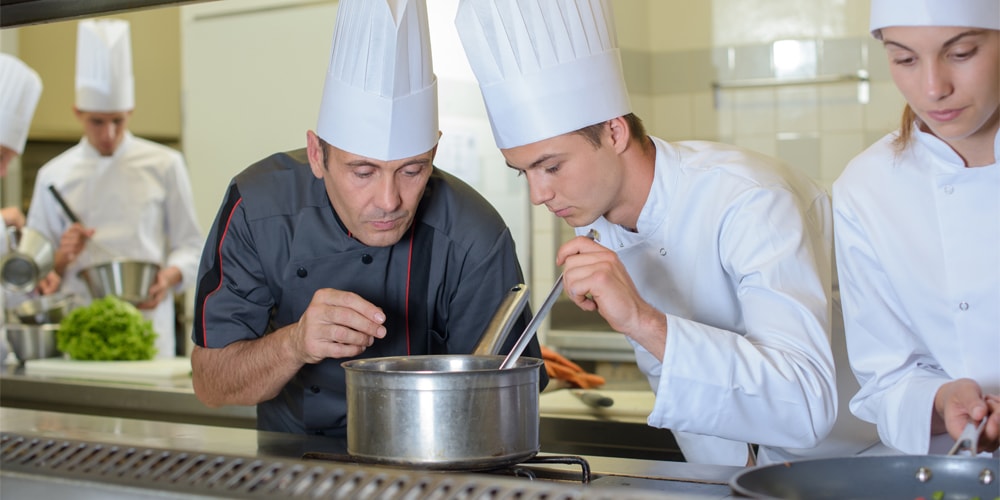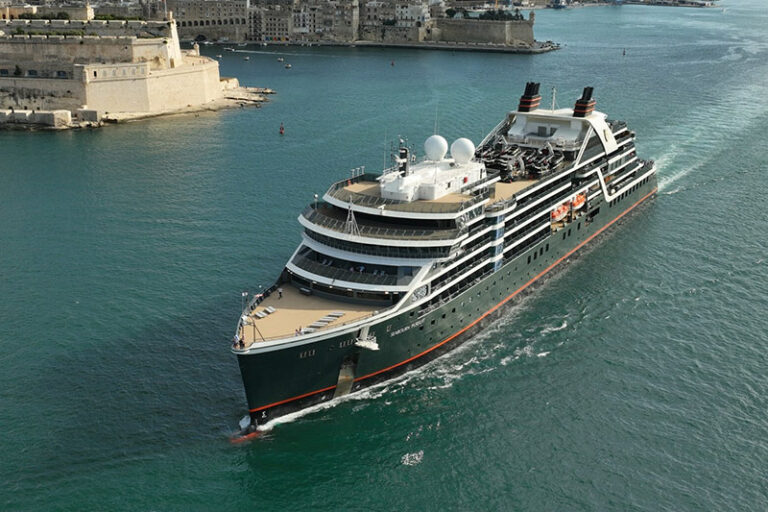Unveiling The Secrets Of Cruise Ship Kitchens
Have you ever wondered what goes on behind the scenes in the kitchens of a cruise ship? From the tantalizing aromas to the intricate preparation of thousands of meals, there is a world of culinary magic happening onboard. In this article, we will peel back the curtain and unveil the secrets of cruise ship kitchens. Whether you’re a first-time cruiser or a seasoned traveler, get ready to discover the inner workings of these floating culinary delights. Get ready to embark on a mouthwatering journey that will leave you hungry for more.
The Scale and Layout of Cruise Ship Kitchens
Understanding the Size of Cruise Kitchen
When it comes to cruise ship kitchens, one of the first things that might catch your attention is their sheer size. These kitchens are massive in order to accommodate the high volume of meals that need to be prepared daily to cater to the hundreds or even thousands of passengers on board. Imagine a bustling city within the ship, where hundreds of chefs and kitchen staff work tirelessly to create culinary masterpieces that will satisfy the appetites of guests.
The Basic Layout of a Cruise Kitchen
To efficiently handle the large number of meals, cruise ship kitchens are designed with careful consideration given to functionality and workflow. The layout of these kitchens typically follows the classic “galley” style, with long counters and workstations positioned in parallel rows. This design allows for a smooth flow of food preparation and service, minimizing disruptions and maximizing efficiency. As you walk through the galley, you’ll notice various stations dedicated to different tasks, such as chopping, cooking, baking, and plating. Each station is equipped with the necessary tools and appliances to carry out its specific function.
Safety Measures in the Kitchen Design
Safety is a top priority in cruise ship kitchens. With so many people working in close proximity and handling potentially dangerous equipment, it’s crucial to have proper safety measures in place. The layout of the kitchen is carefully planned to ensure clear pathways and sufficient space between workstations. Fire safety equipment, such as extinguishers and fire suppression systems, are strategically placed throughout the kitchen to quickly respond to any emergencies. Additionally, strict protocols are in place to ensure proper handling of food, prevention of cross-contamination, and adherence to hygiene practices. These measures help create a safe and efficient working environment for the kitchen staff.
The Operational Dynamics Of A Cruise Ship Kitchen
Multiple Shifts to Ensure 24/7 Service
Cruise ship kitchens operate around the clock to provide continuous dining options for passengers. To accomplish this, the kitchen staff works in multiple shifts, ensuring that there is always a team ready to prepare and serve meals regardless of the time of day. This round-the-clock operation involves staggered shifts, with different teams overlapping to cover the different meal periods. This ensures that all guests have access to a wide variety of dining options, no matter the hour.
The Storage and Inventory Management
With so many meals to be prepared, cruise ship kitchens require extensive storage and inventory management systems. These kitchens must stock a vast array of ingredients, from fresh produce to pantry staples, in order to create diverse menus that cater to various dietary preferences. To manage this efficiently, cruise ship kitchens often utilize state-of-the-art inventory management systems that track and monitor ingredient levels in real-time. This helps prevent shortages, eliminates waste, and ensures that the kitchen is always well-stocked and ready to cater to the gastronomic desires of the passengers.
Meal Planning and Production Cycle
Meal planning on a cruise ship is a meticulous process that involves forecasting passenger demand, determining portion sizes, and creating menus that offer a balanced selection of dishes. The meal planning team takes into account factors such as dietary restrictions, cultural preferences, and the availability of ingredients. Once the menus are finalized, the kitchen staff follows a production cycle that includes preparation, cooking, plating, and delivery of the meals. This cycle is repeated multiple times a day to ensure that passengers can enjoy breakfast, lunch, dinner, and even late-night snacks throughout their cruise journey.

The Cruise Kitchen Staff and Roles
Various Roles within the Kitchen Crew
The cruise ship kitchen is a well-coordinated team effort, with each member playing a crucial role in delivering exceptional culinary experiences. From executive chefs to line cooks, stewards, and pastry chefs, the kitchen crew is composed of talented individuals with diverse skills and expertise. The executive chef oversees the entire kitchen operation, while sous chefs manage specific sections or stations within the galley. Line cooks are responsible for the actual preparation of dishes, following recipes and ensuring quality and consistency. Stewards handle everything from dishwashing to cleaning and organizing the kitchen, while pastry chefs focus on creating delectable desserts and pastries.
Training and Qualifications of the Kitchen Staff
Working in a cruise ship kitchen requires specialized training and qualifications. Most crew members undergo culinary training or hold relevant certifications in order to work onboard. Many chefs have extensive experience working in high-end restaurants and hotels before transitioning to the cruise industry. They possess a deep understanding of various culinary techniques, menu planning, and food safety practices. The kitchen staff undergoes regular training and workshops to stay updated with the latest industry trends and techniques, ensuring that they can consistently deliver top-notch meals to passengers.
Hierarchy and Team Management in the Kitchen
Within the kitchen hierarchy, a well-defined chain of command helps maintain order and efficient operations. The executive chef is at the top of the hierarchy, overseeing the entire kitchen and coordinating with other departments on the ship. Sous chefs and section cooks assist the executive chef in managing daily operations and ensure that each station is running smoothly. Effective team management is crucial in the high-pressure environment of a cruise ship kitchen. The executive chef must foster a cohesive and supportive team culture, promoting open communication and providing guidance to ensure that tasks are executed seamlessly.
The Amazing Food Variety and Preparation
Cuisine Types Available on Cruises
Cruise ship kitchens are known for the incredible variety of cuisines they offer. From international flavors to regional specialties, passengers can embark on a culinary journey of their choosing. Every cruise line strives to cater to the diverse tastes and preferences of its passengers, offering a wide selection of cuisines such as Italian, Asian, Mediterranean, and American. Specialty restaurants on board may also feature cuisines like French, Japanese, or even molecular gastronomy. The cruise ship kitchen teams work tirelessly to recreate each dish authentically, using traditional ingredients and cooking techniques to ensure an unforgettable dining experience.
Catering to Dietary Preferences
In recent years, cruise ship kitchens have become increasingly attentive to dietary preferences and restrictions. They now offer a range of options for passengers with specific dietary needs or preferences, such as vegetarian, vegan, gluten-free, and lactose-free diets. The kitchen staff is trained to handle these requests with care, ensuring that all dietary restrictions are met while still delivering exceptional flavors and presentation. Passengers can communicate their dietary requirements to the cruise line in advance, allowing the kitchen crew to make the necessary preparations and accommodations.
The Artistry Involved in Food Presentation
Food presentation plays a crucial role in creating a memorable dining experience on a cruise ship. From the arrangement of ingredients on a plate to the use of garnishes and sauces, every detail is carefully considered to create visually stunning dishes. The cruise ship kitchen staff takes great pride in their artistry, transforming ordinary ingredients into edible works of art. The creativity and attention to detail involved in food presentation elevate the overall dining experience, enticing passengers with not only the taste but also the visual appeal of the meals.

Sustainability Practices in Cruise Kitchen Operations
Waste Management Practices
Cruise ship kitchens understand the importance of responsible waste management, given the large quantities of food that are prepared onboard. To minimize food waste, kitchen crews carefully track ingredient usage and adjust production quantities accordingly. Leftover food that is still safe for consumption is often repurposed into new dishes or donated to local communities at port destinations. Recycling and composting programs are also implemented to reduce the environmental impact of food waste. By adopting these practices, cruise ship kitchens are actively working towards minimizing their carbon footprint and contributing to a more sustainable future.
Energy Consumption and Conservation
Cruise ship kitchens operate using a significant amount of energy to power various appliances, lighting, and ventilation systems. To reduce energy consumption, cruise lines have implemented energy-efficient equipment and lighting fixtures in their kitchens. Furthermore, kitchen staff are trained to conserve energy by turning off appliances and lights when not in use, as well as utilizing energy-saving settings during food preparation. These small but impactful measures help reduce the cruise ship’s overall energy consumption and contribute to a more sustainable operation.
Sourcing Local and Sustainable Ingredients
Cruise ship kitchens are increasingly focusing on sourcing local and sustainable ingredients to create their culinary masterpieces. By partnering with local suppliers at different port destinations, cruise lines can support regional economies and reduce the carbon footprint associated with long-distance transportation of ingredients. This approach allows passengers to savor fresh, seasonal produce and local delicacies unique to each destination. Additionally, cruise ships actively participate in sustainable fishing practices, ensuring that seafood is sourced responsibly to protect marine ecosystems.
Health and Hygiene Measures in Cruise Kitchens
Laws and Regulations Governing Kitchen Operations
Cruise ship kitchens are subject to strict laws and regulations to ensure the safety and well-being of passengers. These laws cover a wide range of areas, including food handling and storage, hygiene practices, and cleanliness standards. Regular inspections are conducted by health authorities to verify compliance with these regulations. Cruise lines also voluntarily follow international guidelines, such as the Hazard Analysis Critical Control Point (HACCP) system, to maintain the highest standards of food safety and hygiene.
The Cleaning and Sanitization Process
Maintaining cleanliness and hygiene is paramount in cruise ship kitchens. Daily cleaning schedules are meticulously followed, ensuring that all surfaces, utensils, and equipment are thoroughly sanitized. Kitchen staff undergo specialized training in proper cleaning techniques and use approved disinfectants to eliminate any potential risks. Hand hygiene is also emphasized, with frequent handwashing and the use of hand sanitizers being common practices. These stringent cleaning and sanitization processes mitigate the risk of foodborne illnesses and ensure a safe dining experience for passengers.
Dealing with Illness and Allergies
Cruise ship kitchens are equipped to handle various health-related issues, including allergies and illnesses. Passengers are encouraged to communicate any dietary restrictions or allergies to the cruise line in advance, allowing for proper preparations to be made. In cases of food allergies, special care is taken to prevent cross-contamination and ensure that allergens are avoided in meal preparation. Additionally, if a passenger falls ill during the cruise, the kitchen staff works closely with medical personnel to accommodate specific dietary requirements and provide safe, nourishing meals that aid in recovery.
The Specialized Kitchen Equipment On Board
Common Kitchen Tools and Appliances
Cruise ship kitchens are equipped with a wide range of common kitchen tools and appliances that you would find in any professional kitchen. From professional-grade knives and utensils to cutting-edge cooking appliances, the kitchen crew has access to all the necessary equipment to prepare exquisite meals. Commercial-grade ovens, stovetops, grills, and fryers are used to cook dishes to perfection, while mixers, blenders, and food processors assist in creating sauces, dressings, and other culinary creations.
Unique and Advanced Equipment in Cruise Kitchens
In addition to the standard kitchen equipment, cruise ship kitchens often feature unique and advanced appliances that are specifically designed to meet the demanding needs of high-volume meal production. For example, combi ovens are commonly found in cruise ship kitchens. These versatile appliances combine the functions of a convection oven, steamer, and boiler, allowing for efficient cooking of a variety of dishes. Blast freezers are another specialized piece of equipment that enable rapid freezing of prepared meals, preserving their quality and freshness until they are ready to be served.
Maintenance and Repair of Kitchen Equipment
The maintenance and repair of kitchen equipment onboard a cruise ship is a crucial aspect of ensuring smooth operations. Cruise lines have dedicated maintenance teams responsible for conducting regular inspections, servicing, and troubleshooting of all kitchen equipment. This proactive approach helps identify and address any issues before they impact the kitchen’s ability to prepare meals. In the event of equipment failure, quick response teams are equipped to provide timely repairs or replacements, minimizing downtime and ensuring that the kitchen can continue to operate without disruption.
Keeping Up with the Latest Culinary Trends
Onboard Gourmet Experiences
To keep up with evolving culinary trends and cater to passengers’ growing expectations, cruise ship kitchens are continuously innovating and introducing new gourmet experiences onboard. These experiences often include specialty restaurants helmed by renowned chefs, where guests can indulge in a premium dining experience. From immersive tasting menus to wine-pairing dinners, these gourmet experiences offer a unique opportunity to savor exceptional culinary creations and explore the latest trends in fine dining.
Collaboration with Celebrity Chefs
To elevate the quality of their culinary offerings, cruise ships often collaborate with celebrity chefs who bring their expertise and fame to the dining experience onboard. These collaborations allow passengers to sample dishes created by some of the world’s most renowned culinary talents. Celebrity chefs may also offer cooking demonstrations or conduct workshops, providing passengers with the opportunity to learn from the experts and gain insights into their culinary techniques and philosophies.
Innovative Dining Options and Concepts
In addition to traditional dining options, cruise ship kitchens are constantly introducing innovative dining concepts to add excitement and variety to the culinary experience onboard. From interactive food stations to pop-up restaurants and themed dining events, these concepts aim to create unique and memorable dining experiences for passengers. For example, passengers might enjoy a casual street food market one evening and a formal gala dinner the next, allowing them to immerse themselves in different culinary worlds without leaving the ship.

Error Handling and Troubleshooting in Kitchen Operations
Dealing with Supply Shortages
Despite careful planning, supply shortages can sometimes occur in cruise ship kitchens due to unexpected circumstances such as weather disruptions or logistical challenges. In such situations, the kitchen staff must quickly adapt and make the necessary adjustments to the menus without compromising the quality of the dining experience. Resourcefulness becomes essential, as the chefs creatively substitute ingredients or modify recipes to ensure that passengers continue to enjoy delicious meals despite any temporary limitations.
Handling Kitchen Emergencies and Failures
In the fast-paced environment of a cruise ship kitchen, emergencies and equipment failures can occasionally arise. The kitchen staff is trained to handle these situations efficiently and effectively. Quick response protocols are in place to address issues such as power outages, gas leaks, or equipment malfunctions. Backup systems and contingency plans ensure that operations can continue with minimal disruption until the problem is resolved. The ability to remain calm, troubleshoot effectively, and communicate seamlessly within the team is essential in managing kitchen emergencies.
Ingredient Substitutions and Recipe Adaptations
Flexibility is a key skill for cruise ship kitchen staff, as they often face challenges such as ingredient substitutions and recipe adaptations. While the ideal scenario is to have access to the best and freshest ingredients, port restrictions or unforeseen circumstances can sometimes limit availability. In such cases, chefs need to think on their feet and find suitable alternatives without compromising the flavor or quality of the dish. Their expertise and creativity allow them to adapt recipes on the spot, ensuring that passengers can still enjoy a delightful dining experience.
Behind-the-Scenes: Kitchen Tours and Cooking Classes
Opportunities for Passengers to Visit the Kitchen
Cruise lines are increasingly offering opportunities for passengers to go behind the scenes and visit the cruise ship kitchen. These guided kitchen tours provide a unique insight into the inner workings of a cruise ship kitchen, allowing guests to witness the high level of organization, precision, and teamwork that goes into preparing meals for thousands of passengers. Passengers may get a chance to interact with the kitchen staff, ask questions, and even witness the creation of a dish firsthand.
Culinary Workshops and Cooking Demonstrations
Cruise lines recognize that many passengers have a keen interest in culinary arts and offer culinary workshops and cooking demonstrations onboard. These sessions are conducted by professional chefs from the cruise ship kitchen who share their expertise and demonstrate various cooking techniques. Passengers can learn new recipes, gain insights into different culinary cultures, and even get hands-on experience in preparing their own dishes under the guidance of the chefs. These interactive sessions provide a fun and informative way for passengers to enhance their culinary skills and knowledge.
Meet-and-greet Events with the Kitchen Crew
To foster a connection between the passengers and the kitchen crew, cruise lines often organize meet-and-greet events where guests can interact with the chefs and other kitchen staff. These informal gatherings give passengers an opportunity to express their appreciation for the delicious meals they have enjoyed throughout their cruise. The kitchen crew, in turn, appreciates the feedback and recognition for their hard work. These personal encounters create a sense of camaraderie and allow passengers to develop a deeper appreciation for the talent and dedication of the kitchen staff.
In conclusion, cruise ship kitchens are culinary powerhouses that operate round-the-clock to satisfy the appetites of thousands of passengers. The scale and layout of these kitchens are designed to ensure efficiency and productivity, while safety measures are implemented to protect both the staff and the passengers. The kitchen staff, with their diverse roles and expertise, work together seamlessly to produce a wide variety of delicious meals that cater to different dietary preferences. By embracing sustainability practices, following strict health and hygiene measures, and keeping up with culinary trends, cruise ship kitchens continue to push the boundaries of gastronomic experiences at sea. And for curious passengers, kitchen tours, cooking demonstrations, and meet-and-greet events offer a glimpse behind the scenes, allowing them to appreciate the passion and dedication of the kitchen crew who work tirelessly to create unforgettable culinary moments onboard. So, the next time you embark on a cruise, take a moment to savor each bite of your meals and appreciate the culinary masterpieces that have been expertly prepared just for you in the hidden world of the cruise ship kitchen.







